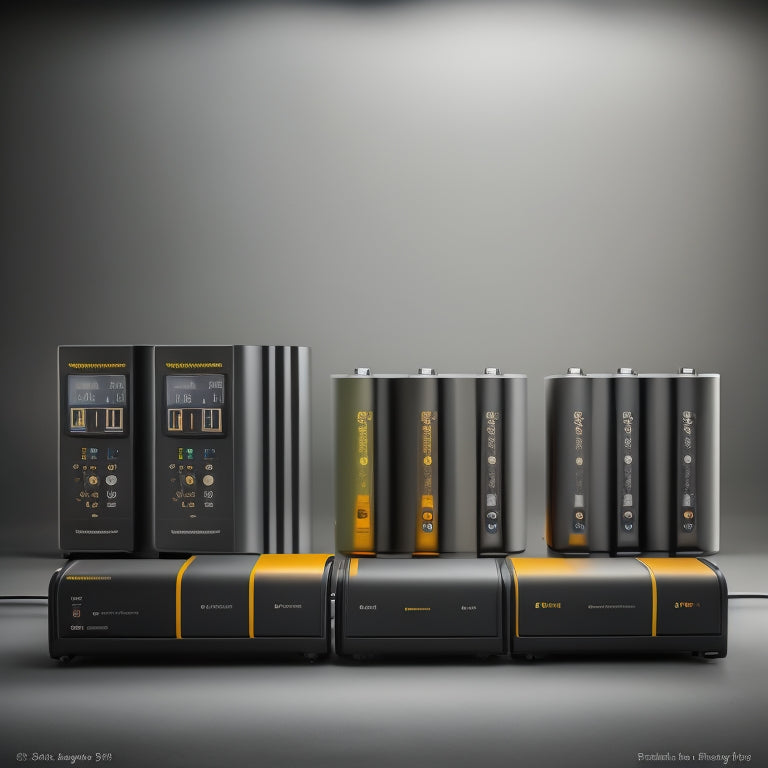
7 Top Home Battery Systems: Capacity Face-Off
Share
You're in the market for a home battery system, and capacity is your top priority. Let's compare the top 7 systems. Tesla Powerwall offers 13.5 kWh, while LG Chem RESU ranges from 3.3 to 12.8 kWh. Sonnen Eco's modular design allows for 2-16 kWh capacity, and SimpliPhi Power recommends an 80% depth of discharge. BYD B-Box and Generac PWRcell also offer modular designs for customization. When it comes to capacity, each system has its strengths. Now, let's explore deeper into the details that can make or break your energy independence - from efficiency metrics to lifespan and warranty considerations.
Key Takeaways
- Tesla Powerwall offers 13.5 kWh capacity, ideal for energy independence, while LG Chem RESU provides a range of 3.3 to 12.8 kWh for diverse energy needs.
- Sonnen Eco's modular design allows for scalability, with capacity ranging from 2 to 16 kWh and a 90% depth of discharge (DOD) for efficient energy storage.
- SimpliPhi Power recommends an 80% DOD to balance discharge efficiency and battery longevity, ensuring optimal performance and extended lifespan.
- BYD B-Box's modular design enables customization and scalability, making it suitable for various energy requirements and installations.
- Capacity is just one factor to consider, as other key metrics like efficiency, energy density, and charging speed also impact overall home battery system performance.
Tesla Powerwall Capacity Review
Optimizing your home's energy storage relies heavily on understanding the capacity of your battery system. When it comes to Tesla's Powerwall, you're looking at a sturdy capacity of 13.5 kWh, making it an ideal choice for energy independence.
Significantly, the Powerwall is certified for seamless integration with existing solar systems, ensuring a hassle-free installation process certified installers. With Tesla Innovations, the Powerwall boasts an impressive efficiency rate of 92.5%, ensuring you get the most out of your solar integration.
Smart Home Compatibility allows for seamless integration with your existing system. Installation considerations are essential, but Tesla's all-encompassing warranty coverage and cost analysis tools help alleviate any concerns.
As you traverse the user experience, you'll appreciate the environmental impact of reducing your carbon footprint. With Tesla's Powerwall, you're one step closer to achieving true energy independence.
LG Chem RESU Battery Comparison
When sizing up your home's energy storage, you'll want to weigh the LG Chem RESU battery against the likes of Tesla's Powerwall.
The LG Chem RESU stands out with its versatility, offering a range of capacities from 3.3 to 12.8 kWh. Its compact design and modular framework make it ideal for homes with limited space.
Additionally, with the potential to save up to $14,500 on fuel costs over 15 years, investing in an electric vehicle and a home battery system like the RESU can be a cost-effective decision in the long run electric vehicles revolutionize savings.
LG Chem features like high-depth discharge and efficient charging/discharging cycles guarantee peak performance.
Regarding applications, the RESU is well-suited for both new and retrofit installations, supporting a variety of inverter brands.
With its extensive warranty and proven reliability, the LG Chem RESU is a strong contender in the home battery market, offering freedom from grid dependence and control over your energy usage.
Sonnen Eco Battery Tech Specs
You're likely considering the Sonnen Eco Battery as a top contender for your home energy storage needs, and rightfully so. This battery system boasts impressive tech specs, with a capacity range of 2-16 kWh and a depth of discharge (DOD) of 90%.
The Sonnen Eco features a modular design, allowing you to scale up or down depending on your energy needs. Additionally, the system comes with advanced features like automatic backup, time-of-use optimization, and smart energy management.
By leveraging solar-powered charging solutions, you can further reduce your reliance on traditional power sources and lower your carbon emissions. With its integration of energy storage systems, the Sonnen Eco can also enhance grid resiliency and optimize charging efficiency.
As for sonnen eco pricing, expect to pay around $10,000 to $20,000 for a fully installed system, depending on the capacity and features you choose.
With its sturdy features and competitive pricing, the Sonnen Eco is an attractive option for those seeking energy independence.
SimpliPhi Power Battery Performance
You're likely wondering how SimpliPhi Power's battery performance stacks up, so let's examine the key factors.
When evaluating energy storage systems, it's crucial to take into account the importance of battery quality and its impact on overall efficiency.
First, you'll want to understand the battery chemistry behind their systems, which affects overall efficiency and lifespan.
Then, you can evaluate the cycle life testing results and depth of discharge to determine the battery's reliability and capacity.
Battery Chemistry Explained
Battery chemistry plays an essential role in determining the performance and overall lifespan of a home battery system.
You're likely familiar with lithium-ion batteries, commonly used in electric vehicles and consumer electronics. However, lead acid batteries are also popular for home energy storage due to their lower upfront cost.
Nickel cadmium batteries, on the other hand, are less common due to environmental concerns. Flow batteries, which store energy in liquid electrolytes, offer high scalability and long lifetimes.
As EV adoption continues to grow, renewable energy sources will play a crucial role in powering these energy storage systems.
When evaluating battery chemistry, consider factors like energy density, thermal stability, and environmental impact. Look for safety features such as thermal management and protective casings.
Cycle Life Tested
SimpliPhi Power's battery performance has been rigorously tested to guarantee its reliability and durability. You want to know how well it holds up over time, and the answer lies in its cycle life testing. This metrics-driven approach helps you compare the lifespan of different home battery systems.
| Performance Metrics | SimpliPhi Power |
|---|---|
| Cycle Longevity | 10,000+ charge cycles |
| Degradation Rate | <5% capacity loss per year |
| Efficiency Rating | 98% round-trip efficiency |
| Warranty Analysis | 10-year warranty with 80% capacity retention |
| Environmental Impact | Minimal maintenance requirements, reducing e-waste |
These performance metrics demonstrate SimpliPhi Power's commitment to providing a reliable and efficient home battery system. With a long cycle life and low degradation rate, you can trust this system to power your home for years to come.
Depth of Discharge
As you evaluate home battery systems, understanding the depth of discharge (DOD) is essential to maximizing performance and lifespan.
DOD refers to the percentage of a battery's capacity that's used during each discharge cycle. A higher DOD means more energy is extracted from the battery, but it can also reduce battery longevity.
SimpliPhi Power's battery system, for instance, has a recommended DOD of 80%, which balances discharge efficiency with battery lifespan. This allows you to harvest more energy from each cycle while maintaining the battery's health.
Generac PWRcell Capacity Analysis
With several Generac PWRcell capacity options available, you're likely considering which one best suits your energy needs.
Generac efficiency is a key factor, with the PWRcell boasting a high round-trip efficiency of up to 96.5%.
Powercell longevity is another essential aspect, with a lifespan of up to 10 years.
When it comes to installation requirements, you'll need a compatible inverter and a suitable location for the battery.
A cost analysis will show that while the upfront cost may be higher, the long-term savings and benefits make it worthwhile.
User feedback has been overwhelmingly positive, with many praising the system's reliability and performance.
Warranty options are also available, providing added peace of mind.
Additionally, the PWRcell has a minimal environmental impact and requires minimal maintenance needs.
Rolls-Surrette Battery Capacity Test
You'll want to examine the Rolls-Surrette battery capacity test's key performance metrics, which include round-trip efficiency, capacity retention, and depth of discharge.
These metrics will give you a clear understanding of the battery's ability to store and deliver energy over its lifespan.
The test's deep cycle testing results will also provide useful perspectives into the battery's performance under various load conditions.
Battery Performance Metrics
Measuring the performance of a home battery system is crucial to guarantee it meets your energy storage needs.
You'll want to evaluate key metrics to verify you're getting the most out of your investment. Battery efficiency, energy density, and charging speed are critical factors to assess.
Thermal management is also essential, as excessive heat can impact performance and lifespan.
Additionally, evaluate lifecycle costs, installation requirements, and warranty terms to guarantee a hassle-free experience.
Environmental impact, brand reliability, and user reviews are also important indicators of a system's overall value.
Deep Cycle Testing Results
Deep into the heart of battery performance lies the Rolls-Surrette battery capacity test, a rigorous deep cycle testing protocol that pushes batteries to their limits.
You'll want to know how your home battery system fares under this intense scrutiny. The test reveals a battery's capacity longevity, measuring how well it retains its capacity over repeated deep discharge cycles.
You'll also get understanding into its deep cycle efficiency, or how effectively it converts stored energy into usable power.
By subjecting batteries to 50 deep discharge cycles, the Rolls-Surrette test simulates real-world usage, providing a realistic assessment of a battery's performance.
As you consider your home battery system, these results will be essential in determining which one will truly give you the energy independence you're looking for.
BYD B-Box Battery Storage Review
The BYD B-Box battery storage system has emerged as a popular choice for homeowners seeking to harness the power of renewable energy.
You'll appreciate the BYD B-Box features, which include a modular design, scalable capacity, and high-depth discharge capability. This system is ideal for those who want to maximize their energy independence.
When it comes to BYD B-Box installation, you can rest assured that it's a relatively straightforward process. The system can be installed both indoors and outdoors, and it's compatible with a wide range of inverters.
With a 10-year warranty and a proven track record of performance, the BYD B-Box is an excellent option for those seeking reliable energy storage solutions.
Frequently Asked Questions
Can I Use Multiple Batteries to Increase My Overall Storage Capacity?
You can definitely use multiple batteries to increase your overall storage capacity, depending on your battery configuration, which affects storage efficiency; by combining batteries, you'll achieve a higher total capacity, but efficiency might vary, so optimize your setup for maximum freedom.
Are Home Battery Systems Compatible With All Solar Panel Systems?
You'll find that most home battery systems are compatible with various solar panel systems, but you'll need to guarantee seamless solar panel compatibility and overcome battery integration challenges to maximize your energy freedom.
How Long Do Home Battery Systems Typically Last Before Replacement?
You'll be relieved to know that home battery systems can have a lengthy "lifespan" of around 10-15 years, depending on your battery maintenance habits, with some lasting up to 20 years, giving you a decent lifetime expectancy from your investment.
Can Home Battery Systems Be Installed Outdoors or in Harsh Environments?
You can install home battery systems outdoors, but you'll need to guarantee they're specifically designed for outdoor installation and can withstand harsh environments, such as extreme temperatures, humidity, and weather conditions.
Are There Any Government Incentives for Installing Home Battery Systems?
Open the treasure chest of incentives! You'll find federal tax credits of up to 26% of the system's cost, plus state rebates, which can greatly sweeten the deal. By installing home battery systems, you'll not only achieve energy independence but also reap environmental benefits.
Related Posts
-

Why Choose Solar Composting Toilets for Your Home?
By choosing a solar composting toilet for your home, you'll greatly reduce your environmental impact, slashing your w...
-

10 Best Energy-Efficient External Hard Drives for Sustainable Offices
When it comes to sustainable offices, you need external hard drives that balance data storage needs with energy effic...
-

7 Top HEPA Filters for Green Building Projects
You need a reliable HEPA filter for your green building project that aligns with your sustainable goals and guarantee...


